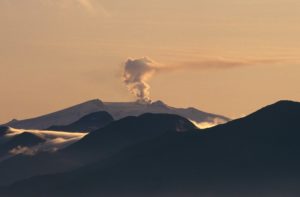
by Ian M. Crosby
In a landmark for UAS operations, Black Swift Technologies is currently working on a project supported by the USGS, NASA and the Alaskan DOT for volcano observations, and is conducting some of the first beyond-visual-line-of-sight (BVLOS) operations for UAS without visual observers or land-based radar.
Makushin Volcano, located on Unalaska Island, Alaska, is ranked within the highest threat category identified by the U.S. Geological Survey’s (USGS) National Volcanic Threat Assessment. The volcano’s activity levels are monitored by the USGS AVO using a network of seismic monitoring stations and webcams installed on and around the volcano, as well as with visits by AVO volcanologists to assess the summit region and sample gases emitted from the summit craters and hydrothermal areas on the flanks of the edifice. However, these surveys can potentially prove hazardous to field crews during times of unrest.
Outfitted with a backup satellite link and real-time data telemetry back to the base station, the aircraft is built to fly beyond visual line of sight during volcano observation missions. The Black Swift S2 volcano observation platform will be deployed to Unalaska Island in the summer of 2021 to observe activity at Makushin Volcano and provide the USGS with monitoring information needed to assess current threat levels.
The UAS survey will play a major role in helping USGS assess activity at Makushin. Gas measurements will be used to check on the possibility of a new magma intrusion at depth, while a photogrammetry survey of the summit will be used to build a digital elevation model and check for possible changes to the vent geometry, size, and distribution as well as inform their understanding of the potential of lahars and debris flows caused by melting of snow and ice.
Additionally, they hope that this initial mission will allow them to deploy the S2 UAS platform to other volcanoes in the U.S. and internationally in the near future, both for gathering baseline monitoring data and in response to volcanic crises or eruptions. It is during these times of unrest that this next-generation UAS platform will provide new opportunities for volcano observation not previously possible with crewed aircraft.
Miriam McNabb is the Editor-in-Chief of DRONELIFE and CEO of JobForDrones, a professional drone services marketplace, and a fascinated observer of the emerging drone industry and the regulatory environment for drones. Miriam has penned over 3,000 articles focused on the commercial drone space and is an international speaker and recognized figure in the industry. Miriam has a degree from the University of Chicago and over 20 years of experience in high tech sales and marketing for new technologies.
For drone industry consulting or writing, Email Miriam.
TWITTER:@spaldingbarker
Subscribe to DroneLife here.